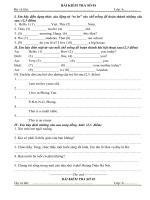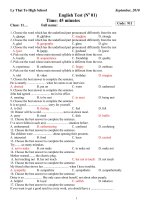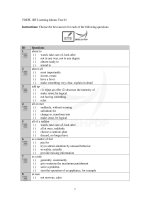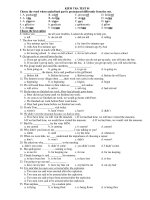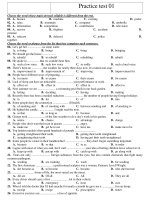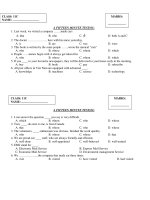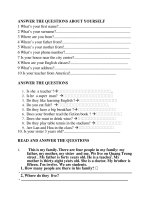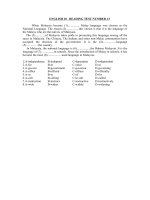- Trang chủ >>
- Đại cương >>
- Toán cao cấp
READING TEST 01
Bạn đang xem bản rút gọn của tài liệu. Xem và tải ngay bản đầy đủ của tài liệu tại đây (85.25 KB, 3 trang )
<span class='text_page_counter'>(1)</span>READING TEST 01 Read the following passage and mark the letter A, B, C, or D on your answer sheet to indicate the correct answer to each of the questions. Today, in many parts of the world, it is customary for people to shake hands upon meeting as gesture of good will. Originally, however, the practice of shaking hands had more practical purpose. Shaking hands originated in medieval times. In those days, when a man came on a stranger, he would often automatically reach for his sword with his right hand, in case he had to use the weapon to defend himself. Sometimes, both parties found themselves circling around each other, weapons in hand, until it was mutually agreed that the weapons could be laid aside. Then, the two parties extended their right hands to show that they had no weapons, and clasped them. This was the beginning of the handshake. The custom of shaking hands is not a universal one. In the Orient, people have, for centuries, clasped their own hands in front of them upon meeting to show that they held no weapons. In France, a custom developed in which people who met would kiss each other on both cheeks. The natives of some South Seas islands greet by rubbing noses. Question 1. The purpose of shaking hands was…. A. just a ceremony showing friendship B. a gesture of good will C. to show that the two parties had no weapons D. to show that both parties were ready for a fight Question 2. To show that one has no intention to fight,…. A. the Oriental people kiss each other’s hand B. shaking hands has been practised all over the world C. there have been various ways depending on different cultures D. people laid aside their weapons Question 3. The practice of shaking hands…. A. is very popular in the world B. is being replaced by other customs C. used to be popular, but now it is out of date D. is considered not to be very polite Question 4. The word “came on” in the 2nd sentence of paragraph 2 can best be replaced by…. A. visited. B. waited for. C. attacked. D. happened to meet.
<span class='text_page_counter'>(2)</span> Read the following passage and mark the letter A, B, C, or D on your answer sheet to indicate the correct answer to each of the questions. The concept of obtaining fresh water from iceberg that is towed to populated areas and arid regions of the world was once treated as a joke more appropriate to cartoons than real life. But now it is being considered quite seriously by many nations, especially since scientists have warned that the human race will outgrow its fresh water supply faster than it runs out of food. Glaciers are a possible source of fresh water that has been overlooked until recently. (A) Three-quarters of the Earth's fresh water supply is still tied up in glacial ice, a reservoir of untapped fresh water so immense that it could sustain all the rivers of the world for 1,000 years. Floating on the oceans every year are 7,659 trillion metric tons of ice encased in 10,000 icebergs that break away from the polar ice caps, more than ninety percent of them from Antarctica. (B) Huge glaciers that stretch over the shallow continental shelf give birth to icebergs throughout the year. Icebergs are not like sea ice, which is formed when the sea itself freezes; rather, they are formed entirely on land, breaking off when glaciers spread over the sea. As they drift away from the polar region, icebergs sometimes move mysteriously in a direction opposite to the wind, pulled by subsurface currents. Because they melt more slowly than smaller pieces of ice, icebergs have been known to drift as far north as 35 degrees south of the equator in the Atlantic Ocean. (C) The difficulty arises in other technical matters, such as the prevention of rapid melting in warmer climates and the funneling of fresh water to shore in great volume. But even if the icebergs lost half of their volume in towing, the water they could provide would be far cheaper than that produced by desalination, or removing salt from water. (D) Question 5: What is the main topic of the passage? A. The movement of glaciers B. Icebergs as a source of fresh water C. Future water shortages D. The future of the world's rivers Question 6: The word “arid” in the first paragraph is closest in meaning to ________. A. anhydrous B. fruitful C. remote D. distant Question 7: The word "it" in the first paragraph refers to ________. A. an iceberg that is towed B. obtaining fresh water from icebergs C. the population of arid areas D. real life Question 8: According to the author, most of the world's fresh water is to be found in ______. A. oceans B. rivers C. glaciers D. reservoirs Question 9: The word “currents” in the third paragraph is closest in meaning to _________. A. pulls B. waves C. weather D. flows of water Question 10: How are icebergs formed? A. They break off from glaciers B. Seawater freezes C. Rivers freeze D. Small pieces of floating ice converge Question 11: With which of the following ideas would the author be likely to agree? A. Towing icebergs to dry areas is economically possible B. Desalination of water is the best way to obtain drinking water C. Using water from icebergs is a very short-term solution to water shortages D. Icebergs could not be towed very far before they would melt.
<span class='text_page_counter'>(3)</span> Question 12: Which is the best place where the following sentence will most properly fit? "To corral them and steer them to parts of the world where they are needed would not be too difficult." A. (A). B. (B). C. (C). D. (D). Question 13: The word "that" in the last paragraph refers to _________. A. the volume. B. the water. C. the iceberg. D. the towing. Question 14: What are the technical matters mentioned as the difficulty arising in the process ofobtaining fresh water from the iceberg? A. The prevention of rapid melting iceberg B. The filtering water and the funneling it to shore in a large amount C. The purifying the fresh water and carrying it to shore D. The prevention of rapid melting and the funneling to shore in great volume Read the following passage and mark the letter A, B, C, or D on your answer sheet to indicate the correct word or phrase that best fits each of the numbered blanks . I was raised on a farm in a remote village in the 1950s. The winter months were endless and everything was covered in snow. I was always (15)________ for the warmer weather to come. When spring arrived, everything came alive- flowers would bloom and the animals would come out of hibernation. I would follow the bear tracks and search for them. Once, however, I (16) ________ an angry mother bear who saw me as a threat. (17) ________ the sight of the bear, I did what my father had told me. I stood still until she stopped growling and walked away. The trick was effective, but looking back now, I realized that the situation was far more serious than I thought at the time. By the age of twelve, I had lots of camping experience , as I used to go camping with my dog on my school holidays. We would spend days (18) ________ the forest, catching fish for dinner, looking at the frogs and the (19) ________ of birds and the insects hopping up and down on the surface of the water. Of course, this was possible only during the warm months. When the autumn came, everything went quiet, which was quite (20)________ in those parts. It wasn’t long before the animals disappeared, the birds flew south and the snow took over. The place became deserted once again. Question 15: A. willing. B. keen. C. eager. D. enthusiastic. Question 16: A. found out. B. came across. C. dealt with. D. reached. Question 17: A. By. B. At. C. On. D. In. Question 18: A. investigating. B. detecting. C. researching. D. exploring. Question 19: A. sets. B. swarms. C. bunches. D. flocks. Question 20: A. usual. B. usually. C. strange. D. changed.
<span class='text_page_counter'>(4)</span>
